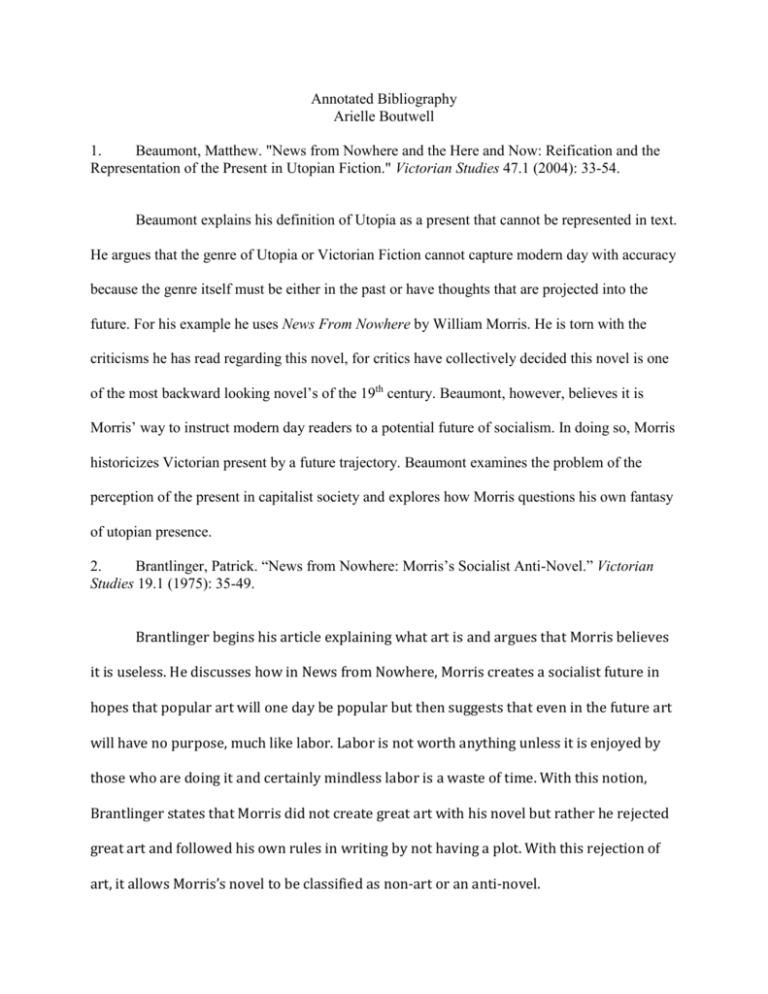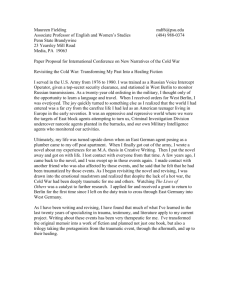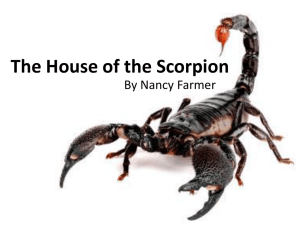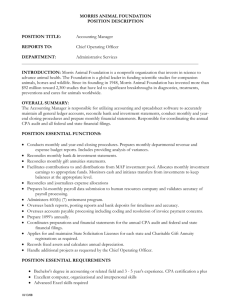annotated bib
advertisement

Annotated Bibliography Arielle Boutwell 1. Beaumont, Matthew. "News from Nowhere and the Here and Now: Reification and the Representation of the Present in Utopian Fiction." Victorian Studies 47.1 (2004): 33-54. Beaumont explains his definition of Utopia as a present that cannot be represented in text. He argues that the genre of Utopia or Victorian Fiction cannot capture modern day with accuracy because the genre itself must be either in the past or have thoughts that are projected into the future. For his example he uses News From Nowhere by William Morris. He is torn with the criticisms he has read regarding this novel, for critics have collectively decided this novel is one of the most backward looking novel’s of the 19th century. Beaumont, however, believes it is Morris’ way to instruct modern day readers to a potential future of socialism. In doing so, Morris historicizes Victorian present by a future trajectory. Beaumont examines the problem of the perception of the present in capitalist society and explores how Morris questions his own fantasy of utopian presence. 2. Brantlinger, Patrick. “News from Nowhere: Morris’s Socialist Anti-Novel.” Victorian Studies 19.1 (1975): 35-49. Brantlinger begins his article explaining what art is and argues that Morris believes it is useless. He discusses how in News from Nowhere, Morris creates a socialist future in hopes that popular art will one day be popular but then suggests that even in the future art will have no purpose, much like labor. Labor is not worth anything unless it is enjoyed by those who are doing it and certainly mindless labor is a waste of time. With this notion, Brantlinger states that Morris did not create great art with his novel but rather he rejected great art and followed his own rules in writing by not having a plot. With this rejection of art, it allows Morris’s novel to be classified as non-art or an anti-novel. 3. Geoghegan, Vincent. “The Utopian Past: Memory and History in Edward Bellamy’s Looking Backward and William Morris’s News From Nowhere.” Utopian Studies 3.2 (1992): 75-90. Geoghegan explains that a Utopian Past genre refers to the belief that Utopia’s conception and orientation to its past is fundamentally important in assessing its character. He discusses Bellamy’s novel in comparison to Morris’s. He argues that Morris’s novel is a response to Bellamy’s. News from Nowhere simply eliminates the comfort of familiarity by creating this new world without much knowledge or memory of how the worlds use to be in the nineteenth century. In comparison with Bellamy’s novel, the two worlds are familiarized. Morris uses the broad questions that Guest ask Old Hammond to allow room for explaining how society should become and how it can achieve this. Morris’s novel was a manual to current readers in how to start a revolution and why it would be beneficial. Therefore, Morris’s novel cannot fall under the Utopian Past genre. 4. Holzman, Michael. “Anarchism and Utopia: William Morris’s News from Nowhere.” ELH 51.3 (1984): 589-603. Holzman article argues that Morris’s novel cannot be an escapist utopian fantasy because it was a political act during that time. Morris wanted to get his ideas and beliefs out into the public so he disguised them in the way of a novel; therefore it is impossible to categorize it as utopian fantasy. Holzman provides quotes to support the idea that some parts in the novel allude to Morris being Old Hammond. Holzman exaplains that there is not the usual separation of character, narrator, and author that is seen in fictional narratives, therefore this novel could not be categorized in such genre. 5. Kinna, Ruth. “The Relevance of Morris’s Utopia.” The European Legacy 9.6 (2004): 739-750. Kinna argues that there is a difference between scholarly estimations of the importance of the novel and how it is treated as a utopia in relation to socialism. Many scholars have been impressed with the successful way Morris has portrayed his novel, while others believe Morris did not intend his writing to be used as a guide to socialism. Kinna compares the standards of classifying Utopia to this novel. She decides that this novel is entirely considered a utopia to these standards, and not Morris’s way of making a guide to achieve socialism. 6. Milner, Andrew. “Tales of Resonance and Wonder: Science Fiction and Genre Theory.” Extrapolation 51.1 (2010): 148. Milner argues his theoretical points about genre. He believes that genre should be constructed by using its characteristic tropes instead of the message it delivers. He illustrates that there is a difference between science fiction in film and in novel. Therefore science fiction is about content rather than form. Some content that he believes are required in science fiction text are resonance and wonder, with the ability to astonish, oftentimes found in pieces considered Utopian or ideological. 7. Suvin, Darko. “Victorian Science Fiction, 1871-85: The Rise of the Alternative History Sub-Genre.” Science Fiction Studies 10.2 (1983): 148-169. Suvin begins his article explaining the time frame that VSF came about, and some sub-genres that he believes can be drawn out of this. He begins with the Extraordinary Voyage, the Future War, and the Alternative History. His article focuses on defining Alternative History. His definition is as another world, dimension, etc. that shares similarities to the writers world, in order to show an easy transition or solution to social problems . He goes on to list novels that fall under this sub-genre. 8. Tattersdill, Will. “Periodicity, Time Travel, and the Emergence of Science Fiction: H.G. Wells’s Temporal Adventures in the Pages of the New Review.” Victorian Periodicals Review 46.4 (2013): 526-534. Tattersdill explores the concept of periodicity in relation to the science fiction genre. He explains how the two are normally not discussed together, however there is a great parallel between the two which is the concept of time. He discusses H.G. Wells’s novel The Time Machine in order to explain the science fiction concept of time and how he argues that the connection between the two is an essential characteristic that deepens the readers understanding of the relationship between science fiction and its medium.







